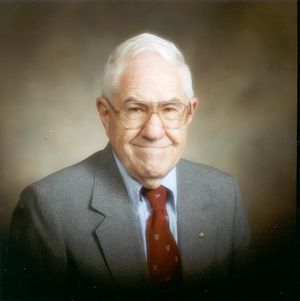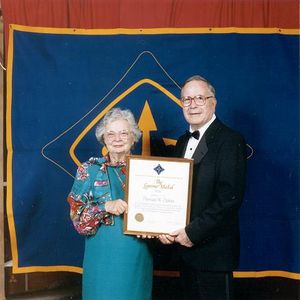Thomas W. Dakin: Difference between revisions
(Created page with "== Biography == Thomas Dakin was born on May 5, 1915 in Minneapolis, Minnesota. He earned a BA from the University of Minnesota and a PhD in physical chemistry from Harvard in ...") |
No edit summary |
||
| (11 intermediate revisions by 2 users not shown) | |||
| Line 1: | Line 1: | ||
== Biography == | == Biography == | ||
[[Image:T. W. Dakin 2266.jpg|thumb|right]] | |||
[[Image:Dakin Lamme Award 0696.jpg|thumb|right]] | |||
Thomas Dakin was born on May 5, 1915 in Minneapolis, Minnesota. He earned a BA from the University of Minnesota and a PhD in physical chemistry from Harvard in 1941. | |||
Dr. Dakin was a | Dr. Dakin spent his career with the Research department of Westinghouse, where he was a renouned specialist on electrical insulation. Early in his years at Westinghouse, Dr. Dakin developed new mathematical models for accounting for the deterioration and resistance of insulators at high temperatures and for the effects of electrical discharges on insulators. He also developed many of Westinghouse’s procedures for systematically testing the endurance of insulators to various weathering conditions | ||
Thomas Dakin died on April 1, 1990. | Dr. Dakin also made major contributions to the development of higher power and more cost efficient capacitors. As with his work on insulation, Dakin created methods to test component life in accelerated time, which facilitated the choosing of the most efficient construction materials. | ||
Dr. Dakin was a [[IEEE Fellow Grade History|fellow of the IEEE]], from which he received the IEEE’s Electrical Insulation Society Award for Technical Achievement, the Westinghouse Order of Merit and the [[IEEE Lamme Medal|Lamme Gold Medal]]. He was a member of the National Research Council’s Conference on Electrical Insulation and Dialectic Phenomena and was elected to the National Academy of Engineering in 1981. | |||
Thomas Dakin died on April 1, 1990. The [http://ewh.ieee.org/soc/deis/2012Dakin.html Thomas W. Dakin Award] of the IEEE is named in his honor. | |||
[[Category:Components, circuits, devices & systems|Dakin]] [[Category:IEEE|Dakin]] [[Category:Awards & fellow activities|Dakin]] | |||
Revision as of 19:58, 12 March 2014
Biography
Thomas Dakin was born on May 5, 1915 in Minneapolis, Minnesota. He earned a BA from the University of Minnesota and a PhD in physical chemistry from Harvard in 1941.
Dr. Dakin spent his career with the Research department of Westinghouse, where he was a renouned specialist on electrical insulation. Early in his years at Westinghouse, Dr. Dakin developed new mathematical models for accounting for the deterioration and resistance of insulators at high temperatures and for the effects of electrical discharges on insulators. He also developed many of Westinghouse’s procedures for systematically testing the endurance of insulators to various weathering conditions
Dr. Dakin also made major contributions to the development of higher power and more cost efficient capacitors. As with his work on insulation, Dakin created methods to test component life in accelerated time, which facilitated the choosing of the most efficient construction materials.
Dr. Dakin was a fellow of the IEEE, from which he received the IEEE’s Electrical Insulation Society Award for Technical Achievement, the Westinghouse Order of Merit and the Lamme Gold Medal. He was a member of the National Research Council’s Conference on Electrical Insulation and Dialectic Phenomena and was elected to the National Academy of Engineering in 1981.
Thomas Dakin died on April 1, 1990. The Thomas W. Dakin Award of the IEEE is named in his honor.

